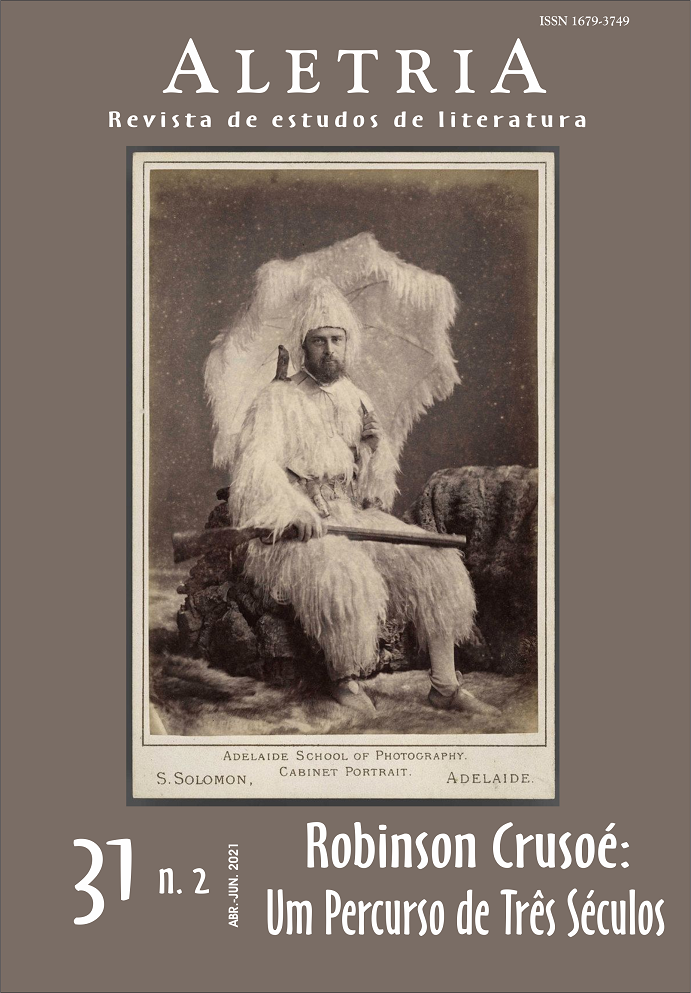Other Islands, Other Deserts
The Negative Turn of Uninhabited Spaces
DOI:
https://doi.org/10.35699/2317-2096.2021.26288Keywords:
dystopia, post-apocalyptic narratives , Robinson Crusoe , The Island of Dr. Moreau , The RoadAbstract
The uninhabited space plays an important role in the modern imagination. Its fascination derives from the wonder felt by the first Europeans to travel to the New World, and it finds one of its most paradigmatical expressions in Robinson Crusoe’s desert island. Originally a place of abundance where the individual found an apparently unlimited opportunity to expand, it surfaces again towards the end of the nineteenth century as a dark and controlled territory with dystopian traits. In this article I discuss the ways this negative turn of the uninhabited space takes place, first in H. G. Wells’ The Island of Dr. Moreau (1896), and then in Cormac McCarthy’s post-apocalyptic novel The Road (2006). In this way I intend to show how the image of the uninhabited space has been represented in differed moments of modernity, and how it is connected to the way we think our position in the world.
Downloads
References
ARMSTRONG, Nancy. How Novels Think: The Limits of Individualism from 1719-1900. Nova York: Columbia University Press, 2005.
BOOKER, M. Keith. The Dystopian Impulse in Modern Literature: Fiction as Social Criticism. Westport, CT: Greenwood Press, 1994.
BOTTING, Fred. Gothic. Londres: Routledge, 2005. DOI: https://doi.org/10.4324/9780203993767.
CLAEYS, Gregory. The Origins of Dystopia: Wells, Huxley and Orwell. In: ______. The Cambridge Companion to Utopian Literature. Cambridge: Cambridge University Press, 2010. p. 107-131. DOI: https://doi.org/10.1017/CCOL9780521886659.005.
DEFOE, Daniel. Robinson Crusoe. 2. ed. Nova York: W. W. Norton, 1994. (Norton Critical Edition).
DOWNIE, Alan. Robinson Crusoe’s Eighteenth-Century Contexts. In: SPAAS, Lieve; STIMPSON, Brian (org.). Robinson Crusoe: Myths and Metamorphoses. Basingstoke, UK: Palgrave Macmillan; Nova York: St. Martin’s Press, 1996. p. 13-27. DOI: https://doi.org/10.1007/978-1-349-13677-3_2.
FRANÇA, Júlio. O Gótico e a presença fantasmagórica do passado. In: ENCONTRO ABRALIC, XV., 2016, Rio de Janeiro. Anais [...]. Rio de Janeiro: Dialogarts, 2016. v. 1, p. 2492-2502.
FUCHS, Barbara. Conquering Islands: Contextualizing The Tempest. In: SHAKESPEARE, William. The Tempest. Nova York: W. W. Norton, 2004. p. 265-285. (Norton Critical Edition).
GREENBLATT, Stephen. Marvelous Possessions: The Wonder of the New World. Chicago: The University of Chicago Press, 1991. DOI: https://doi.org/10.7208/chicago/9780226306575.001.0001.
HICKS, Heather J. The Post-Apocalyptic Novel in the Twenty-First Century: Modernity Beyond Salvage. Basingstoke, UK: Palgrave Macmillan, 2016. DOI: https://doi.org/10.1057/9781137545848.
HURLEY, Kelly. The Gothic Body: Sexuality, Materialism, and Degeneration at the fin de siècle. Cambridge: Cambridge University Press, 1996. DOI: https://doi.org/10.1017/CBO9780511519161.
MCCARTHY, Cormac. A estrada. Tradução de Adriana Lisboa. Rio de Janeiro: Objetiva, 2007. E-book.
MCCARTHY, Cormac. The Road. Nova York: Alfred A. Knopf, 2006.
PUNTER, David. The Literature of Terror: The Gothic Tradition. 2. ed. Londres: Routledge, 2013. v. 1.
PUNTER, David; BYRON, Glennis. The Gothic. Malden, MA: Blackwell, 2004.
SARGENT, Lyman Tower. The Three Faces of Utopianism Revisited. Utopian Studies, [S.l.], v. 5, n. 1, p. 1-37, 1994. Disponível em: http://www.jstor.org/stable/20719246. Acesso em: 30 nov. 2010.
SCHÄFER, Martin. The Rise and Fall of Antiutopia: Utopia, Gothic Romance, Dystopia. Science Fiction Studies, [S.l.], v. 6, n. 3, p. 287-295, 1979. Disponível em: http://www.jstor.org/stable/4239285. Acesso em: 21 jun. 2014.
SHAKESPEARE, William. The Tempest. Nova York: W. W. Norton, 2004. (Norton Critical Edition).
SHOWALTER, Elaine. The Apocalyptic Fables of H. G. Wells. In: STOKES, John (org.). Fin de Siècle/Fin du Globe: Fears and Fantasies of the Late Nineteenth Century. [S.l.]: Palgrave Macmillan, 1992. p. 69-84. DOI: https://doi.org/10.1007/978-1-349-22421-0_5.
THACKER, Eugene. In the Dust of This Planet: Horror of Philosophy. Winchester, UK: Zero Books, 2015. v. 1. E-book.
VASCONCELOS, Sandra Guardini. Robinson Crusoe in the South Atlantic. Aletria: Revista de Estudos de Literatura, Belo Horizonte, v. 31, n. 2, 2021.
WATT, Ian. The Rise of the Novel: Studies in Defoe, Richardson and Fielding. Harmondsworth, UK: Penguin, 1972.
WELLS, Herbert George. The Island of Dr. Moreau. Nova York: Bantam, 1994.
Downloads
Published
How to Cite
Issue
Section
License
Copyright (c) 2021 André Cabral de Almeida Cardoso (Autor)

This work is licensed under a Creative Commons Attribution 4.0 International License.
Authors who publish with this journal agree to the following terms:Authors retain copyright and grant the journal right of first publication with the work simultaneously licensed under a Creative Commons Attribution Non-Commercial No Derivatives License that allows others to share the work with an acknowledgement of the work's authorship and initial publication in this journal.Authors are able to enter into separate, additional contractual arrangements for the non-exclusive distribution of the journal's published version of the work (e.g., post it to an institutional repository or publish it in a book), with an acknowledgement of its initial publication in this journal.Authors are permitted and encouraged to post their work online (e.g., in institutional repositories or on their website) prior to and during the submission process, as it can lead to productive exchanges, as well as earlier and greater citation of published work (See The Effect of Open Access).





